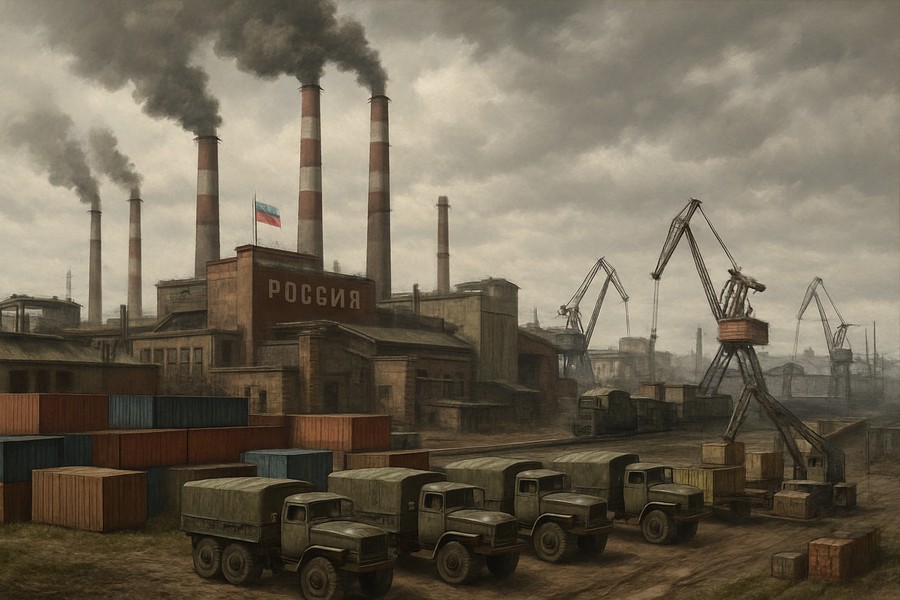
The Fault Lines in Russia's Wartime Economy
Despite ongoing military action against Ukraine, Russia has managed to maintain its economy. This is surprising to many, as the Russian economy has not fully transitioned to a wartime economy. It has, however, significantly increased its production of weapons and expanded its trade with China to bypass Western sanctions. Over the last three years, Russia's economy has performed better than predicted due to government spending, high commodity prices, and effective economic management.
There are two contrasting perspectives on the state of Russia's economy. Russian President Vladimir Putin maintains that the country's economy is resilient and strong enough to support his ambitious plans. These plans include not only sustaining the war in Ukraine but also strengthening and expanding Russia's military capabilities to eventually challenge NATO.
On the other hand, some believe that Russia's economy is on the brink of collapse. However, neither of these views is entirely accurate. The reality is that Russia's ability to build a robust military capable of challenging NATO in the long run is hampered by increasing fiscal pressures, a strained labor market, sanctions blocking access to crucial technologies, and a defense industry that's already operating at full capacity.
Staying Afloat
Despite sanctions and isolation, Russia has managed to keep its military operations running. The government has significantly increased its spending on the military and has been able to maintain the war without fully transitioning to a wartime economy. It has done this by declaring a partial mobilization and encouraging existing defense factories to operate non-stop.
However, these accomplishments are less impressive than they seem. Russia's defense industry had largely reached its peak by 2024, except for drone production. The majority of the equipment now being sent to the Ukrainian front is refurbished, not new, and is often inferior to NATO systems. Corruption and inefficiency remain rampant in the military and defense sectors, and while marginal gains in efficiency are possible, they cannot provide the resources needed for rapid force expansion.
Warning Signs
Russia's war economy functions, but only to a certain extent. The Kremlin is not only restricted by short-term production bottlenecks but also by fiscal strain, an overstretched labor market, technological isolation, and a fragmented defense-industrial base. In essence, defense spending works like a disposable goods economy: factories operate at full capacity, workers earn wages, and demand for inputs surges, but the output is designed to disappear almost immediately. This cycle supports employment and industrial activity in the short term but generates no lasting assets or productivity gains, leaving the economy busier yet poorer with each passing year of war.
Russia's fiscal indicators are a cause for concern. Oil and gas revenues are declining due to lower prices, rising logistical costs, fluctuating exchange rates, and the threat of expanded sanctions. Non-oil revenues are increasing, but not fast enough to compensate, especially as Russia's economic growth slows.
The Labor Shortage
Russia also suffers from a tight labor market. By the end of 2024, Russian firms faced a labor deficit of 2.2 million workers, and 70% of Russian businesses reported they were short on employees. Defense production now competes with construction, transportation, and agriculture for scarce manpower.
Meanwhile, demographic pressures are intensifying. People over 65 already account for 18% of Russia's population, a proportion expected to rise to 24% by the middle of the century. The war has exacerbated this demographic crisis. Hundreds of thousands of working-age men have been killed in Ukraine, and hundreds of thousands more have permanently left the labor force due to injury.
The Patchwork Defense Industry
Russia's defense industry now resembles a patchwork quilt, comprised of state giants, regional workshops, and small firms producing drones and equipment. This decentralized mobilization has proved surprisingly effective in wartime, as small shops can often work faster and more cheaply than traditional large contractors. However, once the war ends, the Russian government will not be able to sustain these firms. It will be easier for the Kremlin to return to a system of centralized plants, bloated procurement, and entrenched corruption.
Opportunity for Adversaries
The structural limits on Russia's economic growth suggest that its planned military resurgence will be slow, uneven, and costly. This provides a window of opportunity for its adversaries to hinder its military buildup. For instance, sanctions and export controls can continue to damage Moscow. They have already forced Russia to substitute imports and develop a dependence on China. If U.S. and European policymakers tighten controls on components such as optics, semiconductors, and advanced machine tools, they can put even more pressure on Russia's economy and industrial base.
